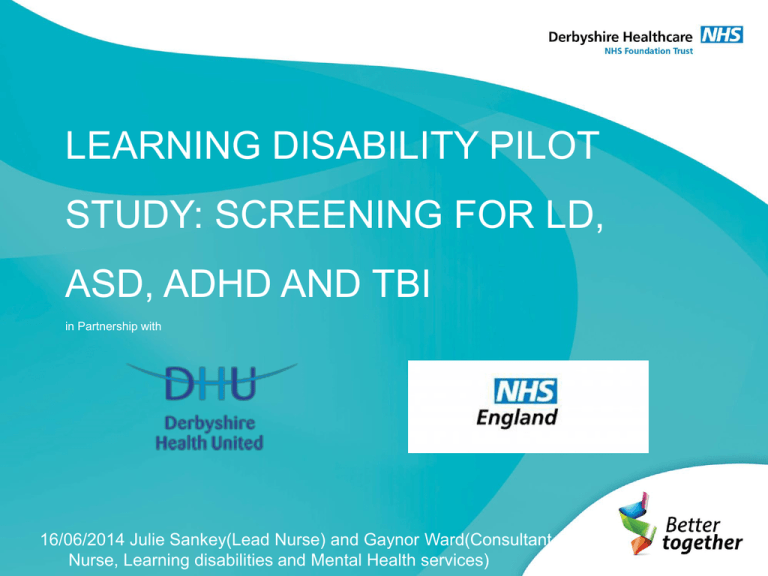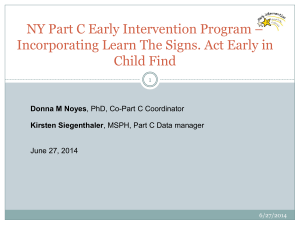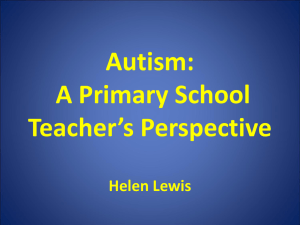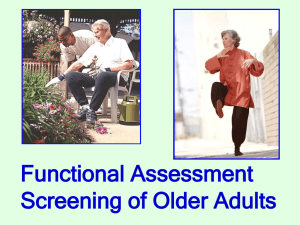Learning Disability Screening in Foston and Sudbury Prisons
advertisement

LEARNING DISABILITY PILOT STUDY: SCREENING FOR LD, ASD, ADHD AND TBI in Partnership with 16/06/2014 Julie Sankey(Lead Nurse) and Gaynor Ward(Consultant Nurse, Learning disabilities and Mental Health services) Offenders with learning difficulties and learning disabilities - review of prevalence and associated needs, ’NO ONE KNOWS’ Nancy Loucks (2007)Prison reform trust Bradley (2009) Lord Bradley’s Review of People with Mental Health Problems or Learning Disabilities in the Criminal Justice System. London: House of Lords. HMP Brixton Mcarthy et al have carried out a study on Neurodevelopmental disorders within HMP Brixton. LD/ADHD/ASD 36% of the prisoners screened in as having significant neurodevelopmental disorders. They used the LDSQ which they stated had a high rate of false positives. HMP Dovegate Bates and Crocombe (2013) An evaluation of an ASD screening tool constructed for use in a prison setting. They highlighted that the sample size was small, that there unable to generalise to conventional prisons settings as all prisoners were from the prison therapeutic community and unable to assist in prevalence of ASD. West Yorkshire Police Custody Middlemiss (2012) carried out LD screening in police custody using the LDSQ tool, they had a 3% prevalence which was significantly lower then that within the prison population which is estimated at 7% All studies carried out so far are small in the numbers of prisoners screened or have only screened for one neurodevelopmental disorder The Proposal To screen for learning disabilities, autistic spectrum disorder, ADHD and Traumatic brain injury by implementing a variety of screening tools within HMP Foston and HMP Sudbury, in conjunction with Derbyshire Healthcare Foundation NHS Trust. AIMS • To identify the prevalence of Learning Disabilities, Autistic Spectrum Disorder, Attention Deficit Hyperactive Disorder and Traumatic Brain Injury, in a set time period, within the two local prisons to inform the development of appropriate pathways and the implementation of reasonable adjustments • To assess a set of screening tools to ascertain if they are fit for purpose for use by Healthcare during the initial health assessment (reception) in terms of inter-rater reliability, time to complete and if they are user friendly. Learning Disability ‘Learning Disability’ is the term that the Department of Health use within their policy and practice documents. In Valuing People (DH 2001) they define a ‘learning disability’ as a: •significantly reduced ability to understand new or complex information, to learn new skills , •reduced ability to cope independently, which starts before adulthood with lasting effects on development. (Department of Health. Valuing People: A New Strategy for Learning Disability for the 21st Century. 2001). Autistic Spectrum Disorder (ASD) The AQ10 was chosen to screen for ASD as recommended by NICE Guidelines Attention Deficit Hyperactive Disorder (ADHD) • Prevalence is 3-4% in children, • Persists with 15% reaching a full diagnosis by 25 years of age, • 50% retain some symptoms leading to continuing impairments on daily life, • Higher rates of recidivism, • 8 times more aggressive. Adult ADHD Self-Report Scale (ASRS-v 1.1) Symptom Checklist Traumatic brain injury (TBI) • An event that could caused a brain injury, • A period of loss of consciousness or altered consciousness after injury. • Or the injury was severe, • And the presence of two or more chronic problems HELPS Brain Injury Screening Tool Neurodevelopmental Disorders • Present from early life, • Affects cognitive, behaviour, social, language development, • Genetic conditions, ASD, LD and ADHD • Lifelong condition. Findings TEST TOTAL MALE FEMALE AQ-10 9(8%) 3(3%) 6(5.5) ADHD 28(25%) 11(10%) 17(15%) HELPS 12(11%) 6(5.5) 6(5.5) HAYES 10(9%) 2(2%) 8(7%) May 2014 Case Studies How we’ve made a difference so far (1). Screen identified a female with LD who required urgent intervention around capacity, consent and help to access universal services in relation to a diagnosis by oncology. An additional clinic and support was offered. (2). A female prisoner screened positive for ADHD and TBI. This TBI was sustained before 18 years of age and she would therefore meet the criteria for learning disability services. She had some speech pronunciation difficulties and was recommended to seek an appropriate referral through the GP. (3). A female prisoner screened positive for ASD and TBI and acknowledge she had addition memory retention deficits. She is currently receiving a service from the specialist PD service (CAMEO). Consent was received to share the screening with all involved to consider the possibility of misdiagnosis and/or ensure reasonable adjustments are implemented. (4).A male prisoner screened positive for ASD. He has service over his tariff and he appears to be having issues/ problems directly related to his communication and understanding of issues. Further assessments and screening have been undertaking and a recommendation for a full diagnostic assessment has been made. • (5). A female prisoner, who was referred by healthcare, attended the screening but unfortunately had difficulty with engagement. ASD characteristic had been suggested by a previous CAMHs service and were noted at point of screening. She was therefore referred to the Mental Health In-Reach team for an LD and MH joint assessment. No mental illness was identified but once again ASD characteristics were identified. Further assessments are planned. • (6). A female prisoner has been having difficulties with completing a fluid intake and out put chart requested by the GP. Previously a nurse and a doctor had talked through the requirements of completing the chart but she was having difficulty with comprehending their requests. An accessible/ easy read version was developed and the GP has asked to carry out a joint appointment. • (7). A male prisoner made a self-referred as he had received a diagnosis of ADHD 2 years ago by a clinic in his local area but he didn’t have a copy of the assessment. He gave permission to obtain a copy of the report and his screen identified symptoms highly consistent with ADHD. A letter was written to his work area supervisor/prison officer offering advice and information on reasonable adjustments for people with ADHD. Patient Journey A female prisoner screened in as having experienced traumatic brain injury. She told the assessor that she had developed speech difficulties after the injury but never received any help for this. She asked for a referral to the GP to discuss if there was any help she could now get. A consented one to one journey was undertaken to ascertain her experiences. Within her narrative she said: ‘. . . . the LD screening has given me hope that someone will help me now with moving forward and the screening tool has helped me and Healthcare to have better understanding of my needs as an individual…..’ Lessons learnt •Recognition that the LD screen needs to be completed before the other assessments otherwise the LD will skew the other tests giving a false positive (e.g. AQ10 is not valid on the LD population), •All tests can be completed within 20 minutes, •We have completed work on the inter-rater reliability •A higher percentage of female prisoners have been identified as having additional needs. However the initial numbers are small and the male and female population is very different: HMP Sudbury is a cat D male open prison with end of term sentenced prisoners whereas HMP Foston is a closed female prison with both remand and sentenced prisoners, •More female prisoners have been identified with GBH and violent crimes in all conditions. No other correlation has been made. Recommendations for Prisons • All 41 people found to have additional needs to have follow-up assessments completed by a Learning Disability Clinician. • The LD (Neurodevelopmental) screening tools to be made mandatory on prison reception, health professionals based at the prison to complete. • NHS England to commission LD support into the prisons. • LD referral pathway to be identified inline with Positive Practice: Positive Outcomes recommendations. • Speech and Language Therapists to assist in the assessment of communication needs specifically related to development of specific person centred offender programmes working in partnership with the prison based forensic psychologists. • All staff receive training on neurodevelopmental disorders and communication. Recommendations for CJS • To pilot the screening tools. • To improve staff knowledge and awareness of neurodevelopment disorders. • Mandatory training for custody sergeants. • Adopt the a definition of learning disabilities. Further work • To offer diagnostic assessments to all prisoners who screened positive for a neurodevelopmental disorder. • To develop appropriate diagnostic pathways for all groups. • To develop appropriate adapted offender programmes for all groups. • Develop staff training in areas such as communication, reasonable adjustments and neurodevelopmental disorders. • To liaise with the Forensic Psychologists on adaptation of rehabilitation programmes. Further work • The screening tools took 20 minutes to complete by a LD Clinician, it may be beneficial to carryout the same screening pilot locally within a custody suite. This would then highlight if the screening tools could be used at first contact with Criminal Justice Services.







